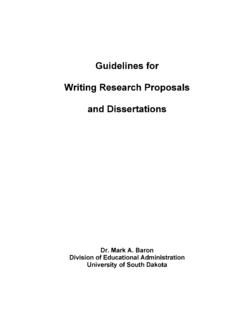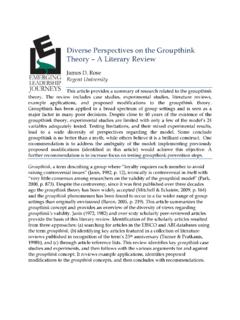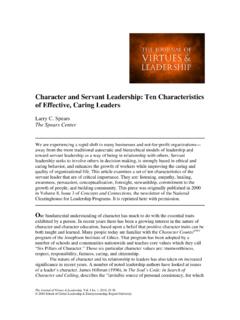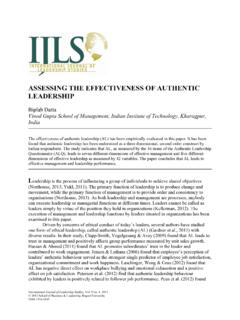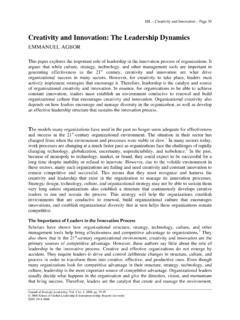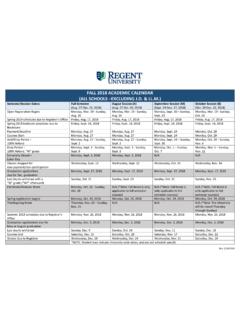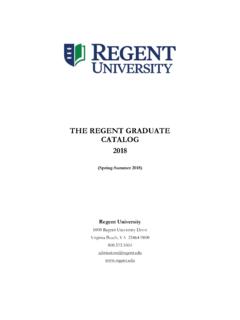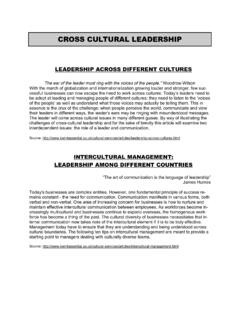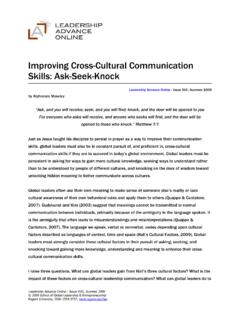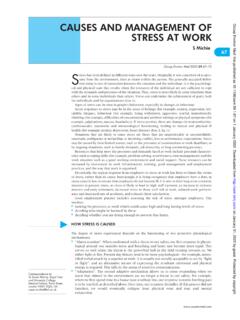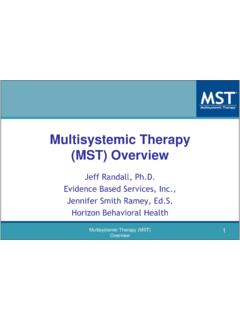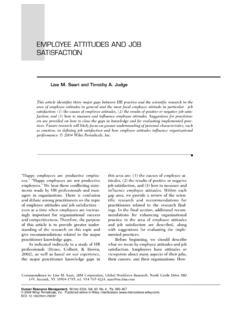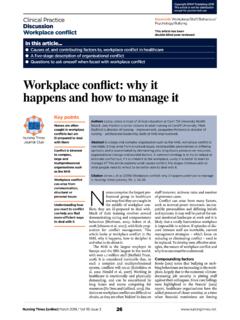Transcription of ASSESSING THE EFFECTIVENESS OF AUTHENTIC LEADERSHIP
1 International Journal of LEADERSHIP Studies, Vol. 9 Iss. 1, 2015 2015 School of Business & LEADERSHIP , Regent University ISSN 1554-3145 ASSESSING THE EFFECTIVENESS OF AUTHENTIC LEADERSHIP Biplab Datta Vinod Gupta School of Management, Indian Institute of Technology, Kharagpur, India The EFFECTIVENESS of AUTHENTIC LEADERSHIP (AL) has been empirically evaluated in this paper. It has been found that AUTHENTIC LEADERSHIP has been understood as a three dimensional, second order construct by Indian respondents. The study indicates that AL, as measured by the 16 items of the AUTHENTIC LEADERSHIP Questionnaire (ALQ), leads to seven different dimensions of effective management and five different dimensions of effective LEADERSHIP as measured by 42 variables.
2 The paper concludes that AL leads to effective management and LEADERSHIP performance. LEADERSHIP is the process of influencing a group of individuals to achieve shared objectives (Northouse, 2013; Yukl, 2011). The primary function of LEADERSHIP is to produce change and movement, while the primary function of management is to provide order and consistency to organisations (Northouse, 2013). As both LEADERSHIP and management are processes, anybody can execute LEADERSHIP or managerial functions at different times. Leaders cannot be called as leaders simply by virtue of the position they hold in organizations (Kellerman, 2012). The execution of management and LEADERSHIP functions by leaders situated in organizations has been examined in this paper.
3 Driven by concerns of ethical conduct of today s leaders, several authors have studied one form of ethical LEADERSHIP , called AUTHENTIC LEADERSHIP (AL) (Gardner et al., 2011) with diverse results. In their study, Clapp-Smith, Vogelgesang & Avey (2009) found that AL leads to trust in management and positively affects group performance measured by unit sales growth. Hassan & Ahmed (2011) found that AL promotes subordinates trust in the leader and contributed to work engagement. Jensen & Luthans (2006) found that employee s perception of leaders AUTHENTIC behaviour served as the strongest single predictor of employee job satisfaction , organizational commitment and work happiness. Laschinger, Wong & Grau (2012) found that AL has negative direct effect on workplace bullying and emotional exhaustion and a positive effect on job satisfaction .
4 Peterson et al. (2012) find that AUTHENTIC LEADERSHIP behaviour exhibited by leaders is positively related to follower job performance. Peus et al. (2012) found Datta / INTERNATIONAL JOURNAL OF LEADERSHIP STUDIES 63 International Journal of LEADERSHIP Studies, Vol. 9 Iss. 1, 2015 2015 School of Business & LEADERSHIP , Regent University ISSN 1554-3145 that followers satisfaction with supervisor, organisational commitment and extra effort, and perceived team EFFECTIVENESS were outcomes of AL. Hmieleski, Cole, & Baron (2012) found that shared AL has a positive indirect effect on firm performance. Leroy, Palanski & Simons (2012) found that AL is related to follower affective commitment and work role performance.
5 Rego et al. (2012b) find that AL predicts employees creativity. Rego et al. (2012c) found that AL predicts team affective commitment and team potency. Walumbwa et al. (2008) found a positive relationship between AL and supervisor-rated performance. Walumbwa et al. (2010) found that AL was positively related to supervisor rated organizational citizenship behaviour and work engagement. Woolley, Casa, & Levy (2011) reported a positive relationship between AL and followers psychological capital, partially mediated by positive work climate and a significant moderating effect from gender. Walumbwa et al. (2011) found AL to positively affect desired group outcomes like group level performance and citizenship behaviour.
6 According to Gardner et al. (2011), limited amount of empirical research makes it difficult to assess the validity of assertions regarding the positive effects of AL that are commonly advanced by its proponents. Gardner et al. (2011) further state that having recognised the documented relationships between authenticity, engagement and well being (Deci & Ryan, 1995; Kernis, 2003, Kernis & Goldman, 2006), five recent studies (Gardner et al., 2009; Giallonardo, Wong, & Iwasiw, 2010; Macik-Frey, Quick, & Cooper, 2009; Walumbwa et al., 2010; Wong & Cummins, 2009) have explored the relationship between AL and leader/follower engagement, empowerment and well being. Gardner et al. (2009) have encouraged research on the positive effects of AL on these and related outcomes ( , job satisfaction , organizational commitment, and employee and organizational performance).
7 This study has been undertaken to find whether AL can lead to effective management and LEADERSHIP performance in the Indian context. AUTHENTIC LEADERSHIP According to Harter (2002), authenticity can be defined as owning one s personal experiences, be they thoughts, emotions, needs, preferences, or beliefs, processes captured by the injunction to know oneself and behaving in accordance with the true self. Based on the initial definition of AL by Luthans and Avolio (2003), and the underlying dimension of the construct posited by Gardner et al. (2005) and Illies, Morgenson, & Nahrgang (2005), Walumbwa et al. (2008) have defined AL as a pattern of leader behaviour that draws upon and promotes both positive psychological capacities and a positive ethical climate, to foster greater self-awareness, an internalized moral perspective, balanced processing of information, and relational transparency on the part of leaders working with followers, fostering positive self-development.
8 In this definition, self awareness refers to demonstrating an understanding of how one derives and makes meaning of the world and how that meaning making process impacts the way one views himself or herself over time. It also refers to showing an understanding of one s strengths and weaknesses and the multifaceted nature of the self, which includes gaining insight into the self through exposure to others, and being cognisant of one s impact on other people (Kernis 2003). Relational transparency refers to presenting one s AUTHENTIC self (as opposed to a fake or distorted self) to others. Such behaviour promotes trust through disclosures that involve openly sharing information and expressions of one s true thoughts and feelings while trying to minimize displays of inappropriate emotions (Kernis, 2003).
9 Balanced processing refers to leaders who show that they objectively analyze all relevant data before coming to a decision. Such leaders Datta / INTERNATIONAL JOURNAL OF LEADERSHIP STUDIES 64 International Journal of LEADERSHIP Studies, Vol. 9 Iss. 1, 2015 2015 School of Business & LEADERSHIP , Regent University ISSN 1554-3145 also solicit views that challenge their deeply held positions (Gardner et al., 2005). Internalized moral perspective refers to an internalized and integrated form of self-regulation (Ryan & Deci, 2003). This sort of self-regulation is guided by internal moral standards and values versus group, organizational, and societal pressures, and it results in expressed decision making and behaviour that is consistent with these internalized values (Avolio & Gardner, 2005; Gardner et al.)
10 , 2005; Walumbwa et al., 2008). Measurement of AL Based on the above conception of AL, a 16-item AUTHENTIC LEADERSHIP Questionnaire (ALQ) by Avolio, Gardner, & Walumbwa (2007) is available from The ALQ consist of four components: Relational Transparency (5 items), Internalized Moral Perspective (4 items), Balanced Processing (3 items) and Self Awareness (4 items). The ALQ, operationalized and validated by Walumbwa, et al. (2008)and derived from Kernis and Goldman s (2006) multi-component conception of authenticity, was found to be the most frequently used measure of AL by Gardner et al. (2011) in their review of AL literature from 1980 till 2010. Neider & Schriesheim (2011) developed an 8-item AUTHENTIC LEADERSHIP Inventory (ALI) and inferred that it is devoid of some concerns with the ALQ, while urging future researchers to test the ALI further.
